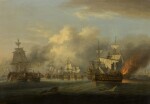Master Paintings
Master Paintings

Property from the Collection of Orin Lehman
Thomas Luny
End of the Battle of Trafalgar, 1805
Auction Closed
May 20, 03:42 PM GMT
Estimate
10,000 - 15,000 USD
Lot Details
Description
Property from the Collection of Orin Lehman
Thomas Luny
St. Ewe, Cornwall 1759 - 1837 London
End of the Battle of Trafalgar, 1805
signed and dated lower left: Luny 1834
oil on canvas
canvas: 24 by 34 in.; 60.9 by 86.3 cm.
framed: 29 ⅝ by 39 ¾ in.; 75.2 by 100.9 cm.
Horatio Nelson’s famous victory over the combined Spanish and French fleets at the Battle of Trafalgar in 1805 was the Royal Navy’s greatest victory - affirming Britain’s maritime supremacy for the next hundred years and dashing Napoleon’s ambitions for an invasion of the British Isles. Lacking a numerical advantage but confident in the superior seamanship and gunnery of his crews, Lord Nelson devised a bold and unorthodox military tactic to split the enemy line by attacking it in two columns. It proved a masterful stroke and the battle was a decisive victory, though it came at a heavy cost. Any yet Nelson’s death, at the moment of his greatest triumph, immortalised his legend as one of the greatest naval commanders in history.
Here Luny depicts the end of the battle, with the French and Spanish ships striking their colours. Vice-Admiral Collingwood'sRoyal Sovereign is seen on the far left of the composition. She was the he first ship of the fleet into action at Trafalgar, leading the starboard column and cutting the enemy line well ahead of the rest of the fleet to engage the Spanish three decker Santa Ana: reportedly prompting Nelson, at the head of the larboard column onboard the Victory, to comment admiringly 'See how that noble fellow Collingwood carries his ship into action!' The two British three deckers in the row of four ships broadside to broadside in the central middle distance are Nelson’s flagship, H.M.S. Victory, with only its foremast standing and her flags on the forestay; and H.M.S. Temeraire, also with only her foremast standing, which is sandwiched between the French two-deckers Redoutable and Fougeux, both of which were captured during the battle. The ship burning on the right is the French Achille which subsequently blew-up.
We are grateful to Dr. Pieter van der Merwe for his assistance with the cataloguing of this lot.
